#Industrial Automotive
Explore tagged Tumblr posts
Text
youtube
Bulgin: The 400 Series Buccaneer
https://www.futureelectronics.com/resources/featured-products/bulgin-400-series-buccaneer-connectors . The 400 Series Buccaneer is ideal for designs requiring a small footprint. The miniature power connectors condenses them into a compact form factor giving engineers greater flexibility. With a light weight and rugged construction, these sealed circular plastic connectors offer highly reliable power for use within medical, industrial, infrastructure and automotive application. https://youtu.be/C-G1ceRQwTY
#Bulgin#400 Series Buccaneer#Compact Connectors#Miniature Power Connectors#Circular Plastic Connectors#Sealed#Rugged Construction#Medical#Industrial Automotive#Infrastructure#Signal Connections#Future Electronics#Youtube
0 notes
Text

#classic car#classic cars#car photo#cars#vintage cars#automobile#automotive#auto#car#car rental#car and driver#car porn#car industry#classic design#classic aesthetic#aesthetic
1K notes
·
View notes
Text

if you can’t identify what i’m thinking about at any given moment there’s a nonzero chance it’s train systems
373 notes
·
View notes
Photo
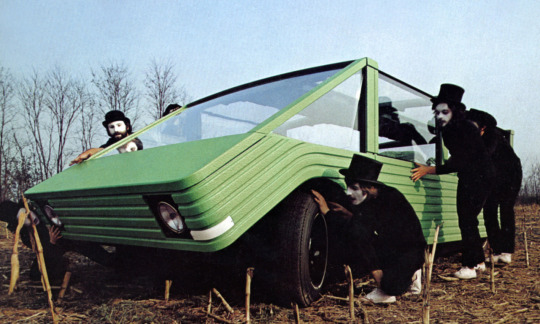
Wheels of freedom: Citroën Kar-A-Sutra, a futuristic vision of automotive design ➤
94 notes
·
View notes
Text

Vertical parking garage in Chicago. [1936]
#architecture#automotive#film photography#analog#urban#chicago#industrial#black and white#monochrome#30s#photography#u
97 notes
·
View notes
Text
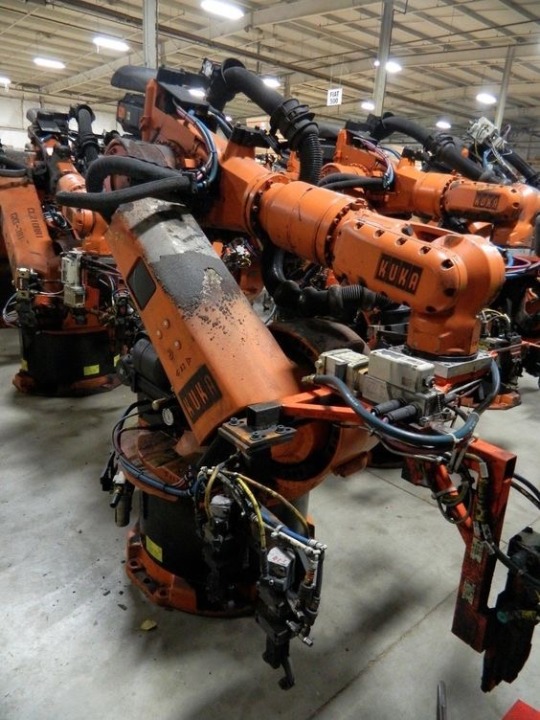
industrial robots
#KUKA#robot#industrial robot#manufacturing#heavy industry#automotive#FIAT#Italy#Torino#Turin#FIAT 500
212 notes
·
View notes
Text
Umbrellas and automobiles are different. Not just because of size, function, and cost. But for a reason we seldom stop to consider. A person can use an umbrella without buying another product. An automobile, by contrast, is useless without fuel, oil, repair services, spare parts, not to mention streets and roads. The humble umbrella, therefore, is a rugged individual, so to speak, delivering value to its user irrespective of any other product. The mighty auto, by contrast, is a team player completely dependent on other products. So is a razor blade, a tape recorder, a refrigerator, and thousands of other products that work only when combined with others. The television set would stare blankly into the living room if someone somewhere were not transmitting images to it. Even the lowly closet hanger presupposes a rack or bar to hang it on. Each of these is part of a product system. It is precisely their systemic nature that is their main source of economic value. And just as "team players" must play by certain agreed-on rules, systemic products need standards to work. A three-pronged electrical plug doesn't help much if all the wall sockets have only two slots. This distinction between stand-alone and systemic products throws revealing light on an issue that is widening today's information wars all around the world. The French call it la guerre des normes—“the war over standards." Battles over standards are raging in industries as diverse as medical technology, industrial pressure vessels, and cameras.
Alvin Toffler, Powershift: Knowledge, Wealth, and Power at the Edge of the 21st Century
#quote#Alvin Toffler#Toffler#power#powershift#technology#standards#automotive#umbrellas#systems#products#product design#industry#cars
248 notes
·
View notes
Note
General Lee, KITT, the DeLorean, or Christine, which would each of you own?



(( Why Christine, sweet Jesus, you could have put there, Idk, HERBIE, that's way more child friendly lol ))
#courtier automotive and others#Paw Patrol#Zuma#Marshall#Rocky#Paw Patrol Zuma#Paw Patrol Marshall#Paw Patrol Rocky#Dukes of Hazzard#General Lee#Knight Rider#KITT#KI2T#KI3T#Knight Industries Two Thousand#Knight Industries Three Thousand#Back To The Future#DeLorean#Christine Plymouth Fury#Herbie The Love Bug#Herbie Fully Loaded#Herbie
40 notes
·
View notes
Text

Illustration detail from the General Motors’ automotive design instructional booklet, Modes and Motors - 1938.
#vintage illustration#vintage brochures#industrial design#design#automotive design#art deco#automobile design#motor car design#gm#general motors#the 30s#the 1930s#30s design#30s style#30s cars#vintage cars#vintage automobiles
31 notes
·
View notes
Photo
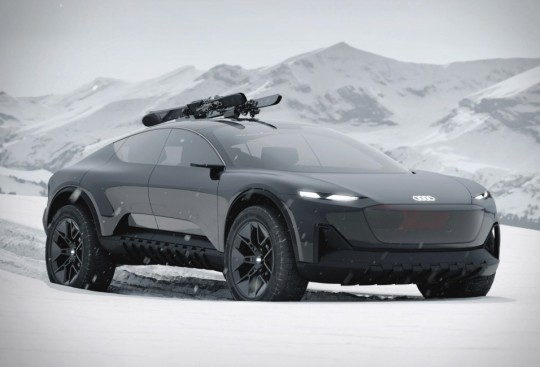



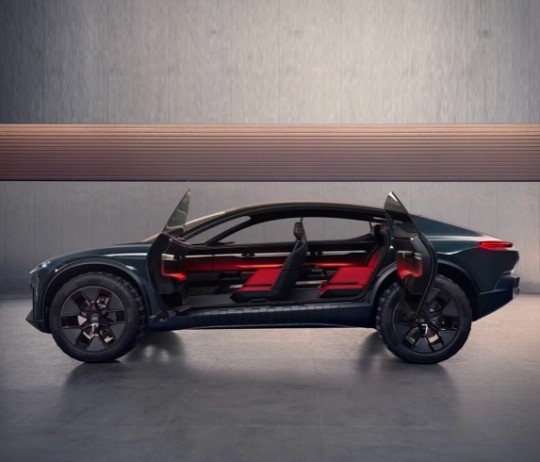
audi activesphere concept
356 notes
·
View notes
Text
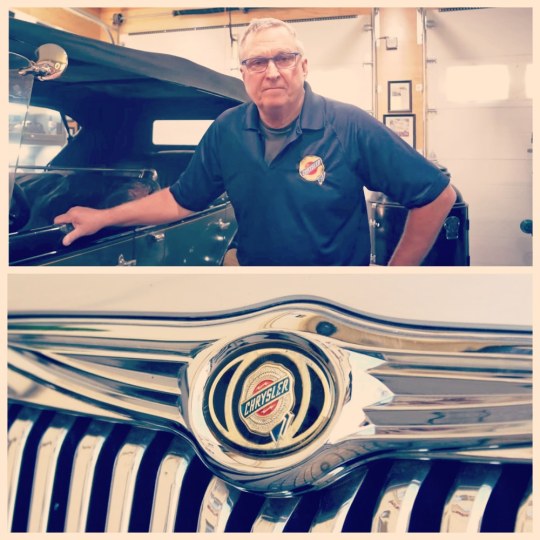
🇺🇸 As we approach Chrysler's 100th anniversary, Frank B. Rhodes Jr., great-grandson of company founder Walter P. Chrysler, is raising concerns about the brand’s future and wants to take action to rescue it. In a recent open letter to “investors and workers,” Rhodes announced his plan to revitalize Chrysler and its related brands—Dodge, Ram, and Jeep—under new “American” ownership.
🚗 Stellantis, the current parent company of Chrysler, has come under criticism from Rhodes for its management of the brand, which he claims has been severely neglected. The Chrysler brand currently offers only one vehicle, the Pacifica minivan, while several promising concept cars, such as the Chrysler Airflow, were shelved before reaching production. Rhodes highlighted Stellantis’ focus on European brands like Citroën and Peugeot, arguing that Chrysler has been left behind.
💼 Rhodes, who has been a Chrysler ambassador for over 40 years, points to his family’s legacy and his own ownership of the final Chrysler 300C as reasons for his dedication to the brand. He submitted a 17-page proposal to Stellantis executives, inviting them to a confidential discussion on reviving Chrysler. His plan includes giving equity stakes to employees, echoing the worker-centered vision of his great-grandfather, who founded the company on principles of American ingenuity and innovation.
📉 Rhodes also expresses concern about the future of Dodge, which has focused heavily on electric vehicles (EVs) despite its core customer base being more interested in American muscle and performance cars. He argues that Stellantis’ push toward an all-electric lineup by 2028 for Chrysler is out of step with market trends, where hybrids are gaining popularity. The all-electric path, Rhodes warns, could be disastrous for the brand’s future.
🔧 Despite these challenges, Rhodes remains optimistic about the potential to rebuild Chrysler as a symbol of blue-collar luxury and innovation. He is calling for a return to American-designed and built products, and greater autonomy for Chrysler and Dodge within Stellantis. Rhodes’ ultimate goal is to rescue the brand from what he sees as poor management and ensure that Chrysler survives to celebrate its next century.
🚨 As Chrysler fans prepare for the 100th anniversary celebrations next summer, including a large event in Pennsylvania, Rhodes is urging action to prevent the brand from fading into obscurity. Without intervention, he warns, Chrysler’s future looks bleak.
#transatlantic torque#brits and yanks on wheels#companies#technology#brands#engineering#cars#tech#old cars#innovation#business and industry sectors#history#chrysler#dodge#Plymouth#walter chrysler#detroit#michigan#big three#Chrysler Motors#automotive#american auto#automobile#classic cars#car#made in usa#stellantis#fiat chrysler automobiles#american company#american car
10 notes
·
View notes
Text

#mercedes#classic cars#classic car#old cars#old car#vintage cars#automobiles#automotive#auto#automobile#car photo#cars#car photography#luxury car#expensive#rich life#luxury aesthetic#luxurious#luxury#car industry#car interior detailing#vintage aesthetic
114 notes
·
View notes
Text
Ko-fi prompt from @thisarenotarealblog:
There's a street near me that has eight car dealerships all on the same lot- i counted. it mystifies me that even one gets enough sales to keep going- but 8?? is there something you can tell me that demystifies this aspect of capitalism for me?
I had a few theories going in, but had to do some research. Here is my primary hypothesis, and then I'll run through what they mean and whether research agrees with me:
Sales make up only part of a dealership's income, so whether or not the dealership sells much is secondary to other factors.
Dealerships are put near each other for similar reasons to grouping clothing stores in a mall or restaurants on a single street.
Zoning laws impact where a car dealership can exist.
Let's start with how revenue works for a car dealership, as you mentioned 'that even one gets enough sales to keep going' is confusing. For this, I'm going to be using the Sharpsheets finance example, this NYU spreadsheet, and this Motor1 article.
This example notes that the profit margin (i.e. the percentage of revenue that comes out after paying all salaries, rent, supply, etc) for a car dealership is comparatively low, which is confirmed by the NYC sheet. The gross profit margin (that is to say, profits on the car sale before salaries, rent, taxes) is under 15% in both sources, which is significantly lower than, say, the 50% or so that one sees in apparel or cable tv.
Cars are expensive to purchase, and can't be sold for much more than you did purchase them. However, a low gross profit margin on an item that costs tens of thousands of dollars is still a hefty chunk of cash. 15% gross profit of a $20,000 car is still $3,000 profit. On top of that, the dealership will charge fees, sell warranties, and offer upgrades. They may also have paid deals to advertise or push certain brands of tire, maintenance fluids, and of course, banks that offer auto loans. So if a dealership sells one car a day, well, that's still several thousand dollars coming in, which is enough to pay the salaries of most of the employees. According to the Motor1 article, "the average gross profit per new vehicle sits at $6,244" in early 2022.
There is also a much less volatile, if also much smaller, source of revenue in attaching a repairs and checkup service to a dealership. If the location offers repairs (either under warranty or at a 'discounted' rate compared to a local, non-dealership mechanic), state inspections, and software updates, that's a recurring source of revenue from customers that aren't interested in purchasing a car more than once a decade.
This also all varies based on whether it's a brand location, used vs new, luxury vs standards, and so on.
I was mistaken as to how large a part of the revenue is the repairs and services section, but the income for a single dealership, on average, does work out math-wise. Hypothesis disproven, but we've learned something, and confirmed that income across the field does seem to be holding steady.
I'm going to handle the zoning and consolidation together, since they overlap:
Consolidation is a pretty easy one: this is a tactic called clustering. The expectation is that if you're going to, say, a Honda dealership to look at a midsize sedan, and there's a Nissan right next door, and a Ford across the street, and a Honda right around the corner, you might as well hit up the others to see if they have better deals. This tactic works for some businesses but not others. In the case of auto dealerships, the marketing advantage of clustering mixes with the restrictions of zoning laws.
Zoning laws vary by state, county, and township. Auto dealerships can generally only be opened on commercially zoned property.
I am going to use an area I have been to as an example/case study.
This pdf is a set of zoning regulations for Suffolk County, New York, published 2018, reviewing land use in the county during 2016. I'm going to paste in the map of the Town of Huntington, page 62, a region I worked in sporadically a few years ago, and know mostly for its mall and cutesy town center.
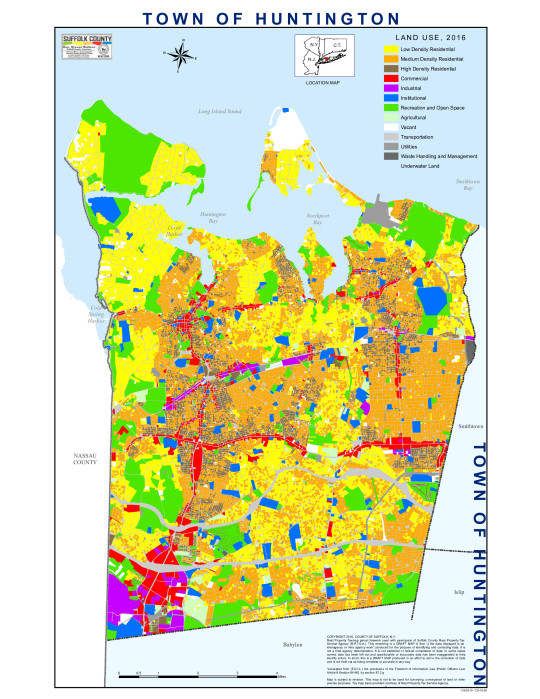
Those red sections are Commercially Zoned areas, and they largely follow some large stroads, most notably Jericho Turnpike (the horizontal line halfway down) and Walt Whitman Road (the vertical line on the left). The bulge where they intersect is Walt Whitman Mall, and the big red chunk in the bottom left is... mostly parking. That central strip, Jericho Turnpike, and its intersection with Walt Whitman... looks like this:

All those red spots are auto dealerships, one after another.
So zoning laws indicate that a dealership (and many other types of commercial properties) can only exist in that little red strip on the land use map, and dealerships take up a lot of space. Not only do they need places to put all of the cars they are selling, but they also need places to park all their customers and employees.
This is where we get into the issue of parking minimums. There is a recent video from Climate Town, with a guest spot by NotJustBikes. If you want to know more about this aspect of zoning law, I'd recommend watching this video and the one linked in the description.
Suffolk county does not have parking minimums. Those are decided on a town or village level. In this case, this means we are looking at the code set for the town of Huntington. (I was originally looking on the county level, and then cut the knot by just asking my real estate agent mom if she knew where I could find minimum parking regulations. She said to look up e360 by town, and lo and behold! There they are.)
(There is also this arcgis map, which shows that they are all within the C6 subset of commercial districting, the General Business District.)
Furniture or appliance store, machinery or new auto sales - 1 per 500 square feet of gross floor area
Used auto sales, boat sales, commercial nurseries selling at retail - 5 spaces for each use (to be specifically designated for customer parking) - Plus 1 for each 5,000 square feet of lot area
This is a bit odd, at first glance, as the requirements are actually much lower than that of other businesses, like drive-in restaurants (1 per 35 sqft) or department stores (1 per 200 sqft). I could not find confirmation on whether the 'gross floor area' of the dealership included only indoor spaces or also the parking lot space allotted to the objects for sale, but I think we can assume that any parking spaces used by merchandise do not qualify as part of the minimum. Some dealerships can have up to 20,000 gross sqft, so those would require 40 parking spaces reserved solely for customers and employees. Smaller dealerships would naturally need less. One dealership in this area is currently offering 65 cars of varying makes and models; some may be held inside the building, but most will be on the lot, and the number may go higher in other seasons. If we assume they need 30 parking spaces for customers and employees, and can have up to 70 cars in the lot itself, they are likely to have 100 parking spaces total.
That's a lot of parking.

Other businesses that require that kind of parking requirement are generally seeing much higher visitation. Consider this wider section of the map:
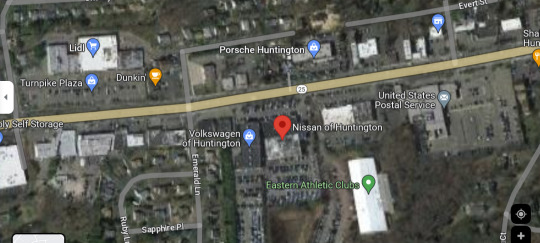
The other buildings with comparative parking are a grocery store (Lidl) and a post office (can get some pretty high visitation in the holiday season, but also just at random).
Compare them, then, to the "old town" section of the same town.
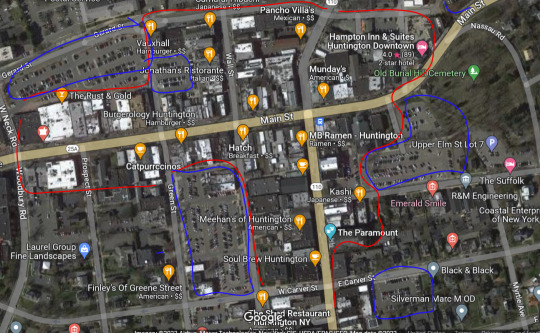
There are a handful of public parking areas nearby (lined in blue), whereas the bulk of the businesses are put together along this set of streets. While there is a lot of foot traffic and vehicle passage, which is appealing for almost any business, opening a car dealership in this area would require not only buying a building, but also the buildings surrounding it. You would need to bulldoze them for the necessary parking, which would be prohibitively expensive due to the cost of local real estate... and would probably get shot down in the application process by city planners and town councils and so on. Much easier to just buy land over in the strip where everyone's got giant parking lots and you can just add a few extra cramped lanes for the merchandise.
Car dealerships also tend to be very brightly lit, which hits a lot of NIMBY sore spots. It's much easier to go to sleep if you aren't right next to a glaring floodlight at a car dealership, so it's best if we just shove them all away from expensive residential, which means towards the loud stroads, which means... all along these two major roads/highways.
And if they're all limited to a narrow type of zoning already, they might as well take advantage of cluster marketing and just all set up shop near each other in hopes of stealing one of the other's customers.
As consumers, it's also better for us, because if we want to try out a few different cars from a few different brands, it's pretty easy to just go one building down to try out the Hyundai and see if it's better than a Chevy in the same price group.
(Prompt me on ko-fi!)
#economics prompts#marketing#zoning laws#ko fi prompts#ko fi#auto industry#automotive dealerships#car dealerships#phoenix posts
110 notes
·
View notes
Text
the thing about american auto is that everyone is an idiot in a very specific way, BUT when you put them all in a room together, something very special happens…their scant remaining brain cells cancel out. poof! negative brain cells. some of the worst decisions you've ever seen, over and over again. amazing television.
#they should figure out a way to power batteries with that if the sand thing doesn't work out#american auto#the tv show not the us automotive industry#me? starting a short-lived sitcom that was cancelled over a year ago to find out what was going on with ana gasteyer and harriet dyer?#absolutely#and i was not disappointed!
8 notes
·
View notes
Text
With electric vehicle sales in Canada breaking records every year, the demand is clear, say advocates of EVs.
"There is currently very high interest, and that interest is growing," said Louise Lévesque, director of policy at Electric Mobility Canada, a national industry association that works to advance electric transportation.
Environment Minister Steven Guilbeault last week unveiled the federal government's electric vehicle sales mandate regulations, which include a national target of 100 per cent zero-emission vehicle sales by 2035. In making his announcement, Guilbeault also noted how the Canadian marketplace is already experiencing "a rapid shift toward zero-emission vehicles."
But some observers say the market and demand for EVs is more nuanced, that data shows most Canadians still aren't particularly eager to buy one and that the targets laid out by Guilbeault might be difficult to achieve.
"If we have to get to 100 per cent of new car sales by 2035, the path we're on right now won't get us there," said Niel Hiscox, president of Clarify Group Inc., a Canadian-based automotive research and advisory firm. [...]
Continue Reading.
Tagging: @politicsofcanada
30 notes
·
View notes
Text
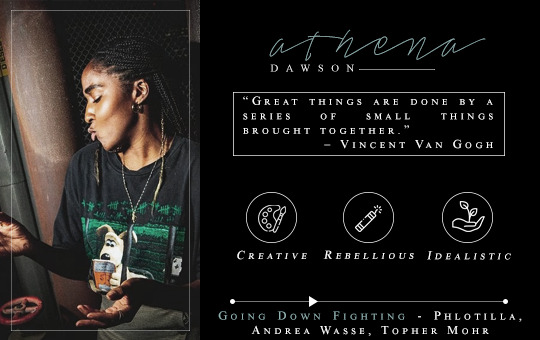

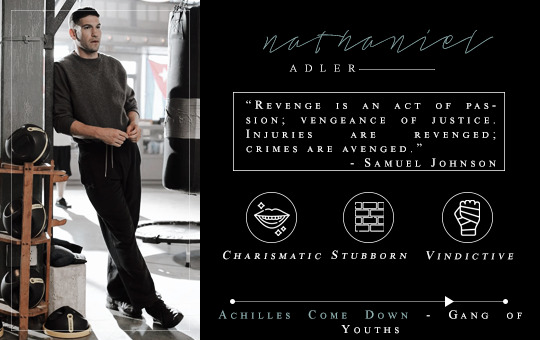
the novice, the scholar, and the stray dog
or, the sole remaining members of the brotherhood's (defunct) detroit bureau in ASSASSIN'S CREED: MOTOR CITY
template made by @unholymilf (tumblr wouldn't let me tag directly, so linking to the blog instead)
#oc: athena dawson#oc: hanan al-saif#oc: nathaniel adler#had to take hephaestus' hammer to free this trio from my brain#which. is an apt analogy since the protagonist of this whole story is named athena#thinking this whole thing takes place in like 2018 but i'm not set on where in the timeline it happens#still ironing things out tbh#two survivors of a templar attack (hanan and nate) and one novice (athena)#and not a single master assassin between them :) they're doing fine :)#historical timeline takes place during the automotive industry boom/prohibition#it's canon henry ford was a templar and i NEED him to get his ass handed to him#also these three have big sibling dynamics (shithead big brother. impulsive youngest sister. poor hanan left in middle child mediation mode#anyway. had to exorcise these guys from my brain#verse: assassin's creed: motor city#my edits
14 notes
·
View notes